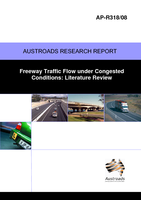Traffic Management

Freeway Traffic Flow Under Congested Conditions: Literature Review
- Publication no: AP-R318-08
- ISBN: 978-1-921329-40-1
- Published: 1 February 2008
- PDF (free) Download
This report provides a literature review on the analyses of the flow breakdown process on a freeway. It begins with the basic freeway flow theory and automatic freeway control tools now in operation. The factors that contribute to flow breakdowns on a freeway include: mainline freeway flow in excess of capacity, uncontrolled access to the freeway from on-ramps, inadequate road geometries, undisciplined driving behaviour, and lack of real-time driver information to encourage better use of alternative routes or lanes. There have been many attempts to develop mathematical models to characterise and understand traffic behaviour. The Lighthill-Whitham model has been useful, despite its limitations, for understanding shock waves at road bottlenecks. Even though most models lack detail and reality, traffic control systems have long been employed to control arterial and freeway traffic with macroscopic relationships. Models for the characterisation of congested freeway flow are described and the Kerner three-phase model is reviewed in some detail.
- AP-R318/08 Freeway Traffic Flow under Congested Conditions: Literature Review
- 1. INTRODUCTION
- 2. BASIC FREEWAY TRAFFIC FLOW THEORY AND CONTROL TOOLS
- 2.1. Basic Traffic Flow Model
- 2.2. Kinematic Wave Model
- 2.3. Automatic Freeway Control Tools
- 2.4. Summary
- 3. MODELS FOR THE CHARACTERISATION OF FREEWAY CONGESTED FLOWS
- 3.1. Two Phase HCM Model
- 3.2. Three Phase Model
- 3.3. Other Models of Flow Breakdowns
- 3.4. Summary
- 4. PROJECT TASKS AND TIMELINE
- 5. CONCLUSIONS
- REFERENCES
Related publications
WEB-R695-G104-2-23
WEB-R695-G104-23
Latest Traffic Management News
